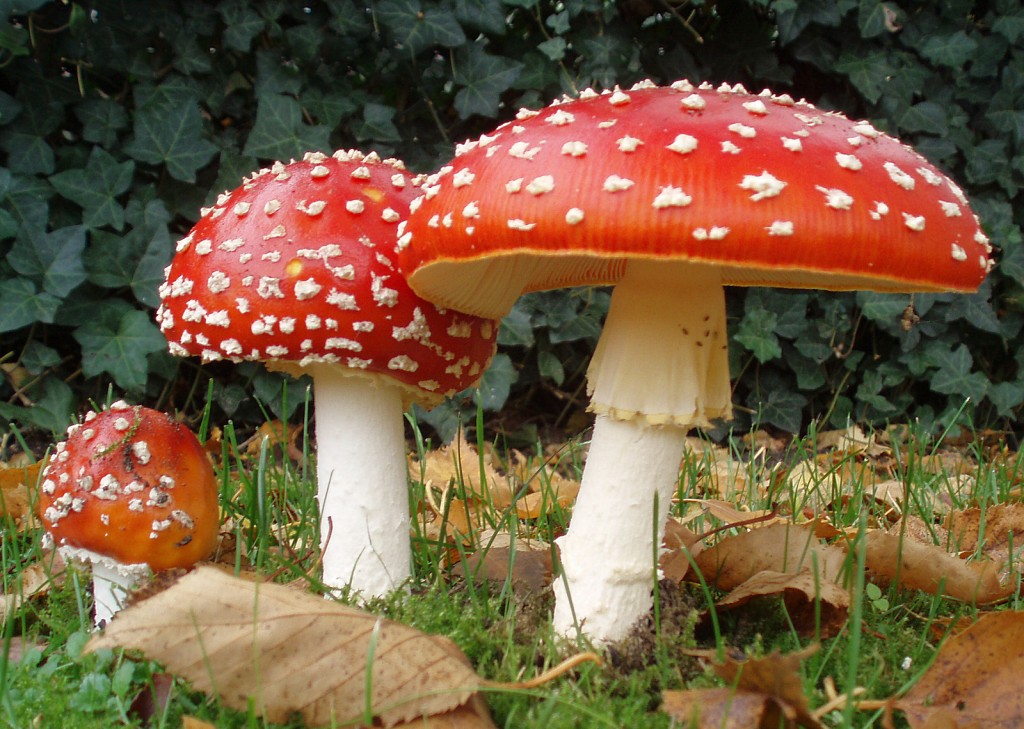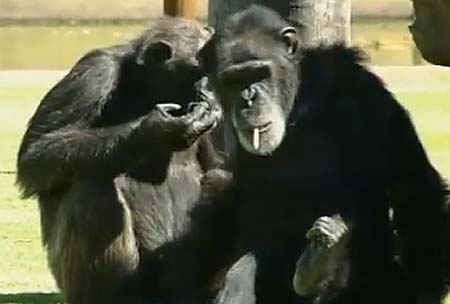In the running battle between the nervous systems of animals and the chemical production factories of plants, animals have learned to convert aversions into affections. Reports of wildlife consuming psychotropic, hallucinogenic, stimulating, or sedating plants for purposes that seem designed for pleasure alone are rife in the scientific literature.
Botanists and zoologists have extensively documented animals deliberately intoxicating themselves. Ducklings too busy feeding on narcotic plants to respond to their mother’s calls. Hawkmoths gorging on the nectar of Datura flowers. Pumas gnawing at the bark of the Cinchona tree are especially noteworthy because of indigenous populations in Peru who noticed the behavior mimicked their own. Centuries later, quinine was isolated from the bark in 1820 and deployed in the battle with the parasitic plasmodium viruses responsible for malaria.
Housecats are notorious fiends for the plant Nepeta cataria, also known as catnip. Interestingly, wild tomcats are less fond of the herb, and pumas, lions, and other wild species belonging to the group of animals known as Felis (cats) are positively averse to it. A captive tiger once “leaped several feet into the air, urinated, and ran head-first into the wall of his cage upon simply sniffing the leaves.”
The tales are endless. Wild bighorn sheep scamper along treacherous mountain ledges in pursuit of psychotropic lichen. Reindeer are drawn like clockwork to Amanita muscaria—also known as fly agaric mushrooms, or red toadstools—seasonally gorging on the fungi and wandering erratically from their migratory paths.

Their ardent attraction to the metabolites of the white-spotted fungus is so strong they will smother themselves in urine left by the people of the Arctic circle who have themselves snacked on fly agarics–even willing to do battle over access to the urine-stained snow. And of course there is the Sclerocarya birrea tree, known more popularly by the butterscotchy liqueur Amarula created from it. The fermented fruit draws African land mammals—most famously elephants (hence the bottle’s label)—to it in aggressive, rowdy hordes.
Animals in the wild habitually consume intoxicating, hallucinogenic, and sedating chemicals. But it is at the intersection between animals, humans, and our own drugs that the story starts to become more interesting. And more questionable.
Take the popular alkaloid nicotine (alkaloids being a broad class of chemicals that includes cocaine, caffeine, morphine, and many other of our favorite drugs). The product of the leaves of N. tobaccum is lethal, as noted, to almost all animals. Except primates. The tiniest doses of the chemical will kill insects, frogs and birds. Yet monkeys and apes are somehow impervious to nicotine’s lethal properties.
You’ve probably seen old film footage from the 1920s of circus chimps smoking cigars (perhaps while roller skating).
Chimps have not only been coaxed into smoking—they have become genuinely addicted. Zookeepers worldwide have struggled to get captive animals to kick the habit, most famously Charlie of the Mangaung Zoo, in Bloemfontein, South Africa, who first became hooked when visitors tossed him lit cigarettes.

Enticing captive apes to smoke is an old and clichéd trick. Chimpanzees have been put on show smoking for centuries. The first recorded instance in Europe took place in The Hague in 1635. It was around this time that the dosing of animals took on a scientific, systematic dimension as medical doctors, chemists, and other enterprising experimentalists of the burgeoning scientific disciplines began to immerse, inject, feed and cloak animals in a variety of psychoactive chemicals, from alcohol to ether, morphine to mescaline.
For better or for worse, the use of animals to investigate the properties of drugs resulted in a number of medical milestones. The first needle (which eventually evolved into the heroin-friendly hypodermic form) was produced by Sir Christopher Wren (1632–1723), who paired goose quills with animal bladders to inject dogs with opium in 1656. Another breakthrough came with the French medic Pierre-Alexandre Charvet (1799–1879), who in 1826 published Action comparée de l’opium et de ses principes constituans sur l’économie animale, a detailed account of his work administering opium to animals, including paramecia, crayfish, snails, fish, salamanders, frogs, birds, rabbits, dogs, cats—and himself. This is regarded by many as the first book in the field we now know as “experimental pharmacology.”
LSD has frequently been given to animals. Guppies dosed with acid swim into the walls of their tanks. Siamese fighting fish display their fighting stance to unoccupied water. Worms work their way upwards through soil. Snails fall from the sides of trees.
Perhaps the most famous experiments on animals with LSD involved spiders, who were dosed with a variety of narcotics in experiments funded by space agency NASA.
Why arachnids? In addition to being cheap and easily sourced, the influence of a drug on the arrangement of a spider’s web seemed to provide a rough indicator of a chemical’s toxicity.
The geometric array is illuminating: Webs made on caffeine are erratic and nonfunctional. Chloral hydrate, also known as the sleeping aid Hydrate, produces a sparse arrangement of threads. Marijuana results in a fairly competent web, but it appears as if the spider abandoned its task halfway through. The LSD web resembles a normal one proportionally, but it is definitively broader. Make of this what you will.
Aside from sheer spectacle, what is the utility in experimenting on animals with drugs? Non-human models cannot make for a perfect replica of the brain of Homo sapiens, but according to many biologists, they serve as a decent proxy.
Psychiatrist Ronald Siegel of the Department of Psychiatry and Biobehavioral Sciences at the University of California Los Angeles spent the better part of 30 years studying the impacts of narcotics on animals. He believed that understanding the biological basis of addiction would aid his treatment of patients suffering the ravages of chemical dependencies. Siegel worked daily as a clinician treating addicts: He saw with his own eyes how drugs destroy lives.
His aims were undoubtedly compassionate and his methods undeniably colorful. He trekked to the mountains of the Andes to understand the ancient use of the coca leaf. He darted a captive colony of chimpanzees off the coast of California with cocaine both at the low concentrations found in the leaf and with the high concentrations found on the street. Result: Coca leaf levels rendered the animals social and cheerful. Miami-style doses led to aggression and disrupted social dynamics. Odd as this may sound, it was not until Siegel’s experiments that cocaine was accepted by the scientific establishment and the general public as “addictive.” Until then, it was merely thought to be habit-forming.
His experiments with the hallucinogen N,N-dimethyltryptamine (DMT) on rhesus monkeys are described with such striking detail that, rather than paraphrasing, they are best quoted verbatim:
Darkness, solitude and the silence of night are the most common times for humans to use hallucinogens. All primitive societies prefer these drugs under conditions when there is little else to see or hear in the environment… In dark and isolated settings, monkeys also find exploring visual stimuli exciting and rewarding. In a classic demonstration of this motivation to explore, rhesus monkeys were confined one at a time to a dimly lighted wire cage that was covered with an opaque box. Because monkeys need visual stimulation as much as we do, I was certain they would accept an enlightening hallucinogen rather than darkness. Initially, each monkey was given the opportunity to live alone in the dark chamber for ten consecutive days and nights. The smoking machine was filled with cigarettes made from ordinary garden lettuce … and the cigarettes were laced with DMT … by Day 8 [Claude] had worked up to smoking almost two whole cigarettes each day … Lucy has been smoking almost two DMT cigarettes each day. She has become extremely proficient at catching whatever she has been chasing: she now brings ‘it’ to her mouth, chews and lip-smacks with delight.
His conclusion: If deprived of light, stimulation, company and comfort, monkeys will smoke an overwhelmingly strong psychedelic. He says this has profound implications for our own species. “Under the right conditions [DMT] was as useful to a monkey as it is to a human. We share the same motivation to light up our lives with chemical glimpses of another world.” One is tempted to suggest that had Dr. Siegel ever tried hallucinogens himself (he maintains that he would never, never, take any of these substances), he wouldn’t have locked a monkey in a dark box to reach this deduction.
Among his peers, opinions are mixed.
“He’s not exactly very popular,” says Rick Doblin, Ph.D., founder of the Multidisciplinary Association for Psychedelic Studies (MAPS), who has endeavored to demonstrate the potential to treat human ailments with psychotropic drugs since the 1970s. “He did tremendously important work, but not everyone is a fan of his methods.”
“I genuinely think of him as a hero,” says medical doctor George Koob, chairman of the Committee on the Neurobiology of Addictive Disorders at the Scripps Institute in California, who has spent his career trying to understand what predisposes some but not others toward addiction. “He really was the first person to chart the case histories of cocaine addiction when nobody thought of it as a ‘addictive drug.’”
Published as an extract in The Daily Beast to celebrate 4:20 – April 20th, the global day to mark the consumption of cannabis.